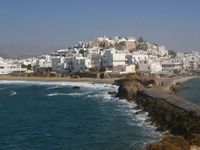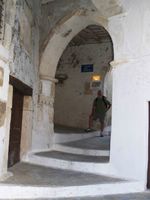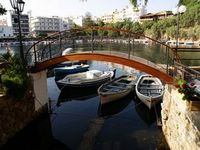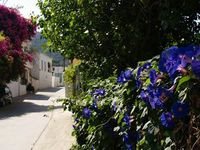
This is the final note on our Greece trip. We travelled from Naxos back to Piraeus on one of these. They are large, vehicle carrying catamarans with seating for about 1200 people in 3 different classes - again fast smooth ride (about 4 hours with one stop in Paros). The only beef is that these allow smoking in the rear compartments, but the smokers seem free to puff and wander through the non smoking areas as long as they don't sit down! This type of vessel is actually built in Australia. 
We arrived in Piraeus, the port for Athens, to find no transfer vehicle waiting for us (yet another black mark against Nolitours - the company organizing that part of the trip). We eventually caught a cab to the hotel - we should have realized that the fact the cab driver had to ask us for the address was not a good sign (fortunately due to prior research, we had the address; the tur company never provided that level of detail). The Kaningos 21 hotel was one of many thrown up quickly for the Olympics and shows it, flashy decor but poor workmanship throughout, now running on a skeleton staff with not the best standards of service, cleaning or maintenance. It is close to the student quarter around Strefi Hill, made infamous when the military junta massacred protesting students there. The neighbourhood is still covered in graffiti, but there is one small corridor of cafes around an open air theatre and we found this delightful little taverna right at the top of the hill. It was Sunday evening and the clientele consisted of large Greek extended family groups which all the tour books recommend as a sign of a good place to eat. They are probably right. 
We spent our last day in Athens wandering around, with a leisurely visit to the Museum of Cycladic Art, which is a somewhat deceptive name as the museum houses a series of private collections from the Cyclades, Cyprus and mainland Greece, and sponsors a pretty eclectic range of temporary exhibits - currently one on relationships between ancient and modern sculpture that is very well done, and in an adjoining small mansion, a display of the life and times of Caravaggio, including examples of his work and painters that he influenced - again very well done. The picture is of one of the many groups of street musicians on the Ermou, the street that defines the Northern edge of the Plaka area of Athens. You can find groups doing every type of music and most of them are pretty good. 
Our last picture - the wine bottle at Kuzina, the restuarant on Adrianou, below the Acropolis where we had lunch and dinner on our last day. Classy way to do an ice bucket!
copyright 2006 Malcolm Ogborn
Jane and Malc on the road
Thursday, July 13, 2006
Saturday, July 08, 2006

Now we�re in Naxos.
To get there from Santorini, you travel on this ship, which involves queuing up with all your luggage with several hundred other people in a building with not a lot of ventilation that is designed for a few hundred fewer people than are actually in it, ready to rush the gangplank when all the heavy vehicles get off. This is rather like rugby without leg tackles being allowed; as Jane and I reached the gangplank, a pair of solidly built middle aged Italian women made a quick dart around the line and tried to hip an shoulder Malcolm out of the way. We think they saw the maple leafs and figured polite Canadians would let them get away with it - they didn�t factor in Australian upbringing - it�s really quite surprising how far you can bounce someone with a deft turn of a 50 lb pack on your back... 
The Mediterranean was far from pleasant on the trip, with 40 to 60 km hour headwinds. On deck, in any open area, you added another 25 or so for the ship speed. There are no inside seating areas and seating is on benches that are welded to deck or cheap plastic chairs that aren�t. You do not want to be downwind of those chairs when someone stands up suddenly - they go flying in the wind. 
The entrance to the harbour of Ios - the one stop en route. Based on the weather we�ve seen, it is no surprise that there is a church at the entrance to every harbour. 
The main town of Naxos, locally called Chora (silent C). 
The Temple of the Dellian Apollo on a small island at the harbour entrance, the official symbol of Naxos. It isn�t a ruin, it was actually never finished in about the 6th century BC. Early archeological evidence of the invention of the committee perhaps� 
Entrance to the old Venetian Castle area in the centre of the old town (actually built by Franks who saw which way the wind was blowing). 
Part of the old market area - a jewelry store. 
Once out of the old area, you have to dodge scooters, motor bikes, quads, beach buggies and cars. The only thing scarier than the way some of the local young men drive them is the way the tourists rent them and try to drive them. 
The nearby beach, Agios Georgios (about 5 minutes walk from the hotel). This was taken today after the wind finally moderated. You will note nobody is very far into the water - as a result of sustained strong northerly winds pushing currents around, it was cold! 
The hotel and pool area where we have whiled away a number of hours in the last couple of days. 
No shortage of places to eat even in this relatively small town and if octopus is your fancy, you can get really up close and personal to it. 
Dinner on the beach, followed by on the Kitron liquer, a local speciality. While all the restaurants serve the standard Greek fare, if you dig a bit deeper in the menu and go for the more obscure dishes, you get specially treated and the food has always been worth the effort. 
Another sunset over Naxos harbour. Back to Athens by high speed ferry tomorrow, one day to get organized and then an early start on Tuesday to come home via Munich and Toronto - estimated travel time of 17 hours!
copyright 2006 Malcolm Ogborn
Wednesday, July 05, 2006

Picassa is acting up again so this post continues from the end of the last one. View from our lunch table on the small island of Thirassia which forms a remnant of the western rim of the caldera that was left after the explosion.
All the villages on the islands in the group are reached by “steps” which double as donkey trails – average price for a ride up is about 4 euros, about $6.50. A step can be a conventional step or it can, as in this picture be a short vertical surface followed a by a steeply sloped cobblestone slope that is well lubricated with….well, there are lots of donkeys so use your imagination! They are really steep – a real workout getting to the top.
Jane engaging in traditional local post lunch activity�..or lack of it!
The village of Oia, where the tourists flock to watch the sunset.
An irresistible Greek picture.
Aforementioned sunset!
The main local cooperative winery. We ended up there today after a bus tour of the island that took us from the main archeological museum through a range of sites and a long lunch by one of the black sand beaches on the south side. Wine, mainly white and a specialized dessert wine called Vinsanto, is the island�s biggest export. 70% of the land is under vines, but you might not recognize it at first as the vines are not on trellises, but pruned close to the ground with stems wrapping around eachother to form a basket shape to protect the fruit from the wind. Picking would be really hard work.
The schedule is now for an evening walk up to caldera rim and dessert, then a ferry to Naxos after breakfast tomorrow.
copyright 2006 Malcolm Ogborn

The ferry that took us from Crete to Santorini. It made the trip in about 1.75 hours which on the back of an envelope calculation means it was traveling pretty close to 80 km/hour. This was in spite of a 4 to 5 foot swell and strong enough Northerly winds for pretty good white caps. The stability and smooth ride was really quite amazing and we would certainly recommend these high speed catamarans as a way to travel between the islands
Unlike the images you get on the travel shows of people streaming on or off large steel hulks, these ferries are like very wide bodied aircraft (18 seats across) and the seating is assigned - we got a window seat but there isn�t a lot to see but sea on the crossing. You can�t go out on the deck when the boat is moving - thankfully, it is non smoking inside!
Our hotel is in the middle of the island capital, Fira, but it is a small town atop the cliffs of the caldera with everything within walking distance and most of the original streets to small for anything other than foot traffic and the occasional motor scooter.
The view from out table at The Flame of the Volcano Taverna where we had lunch on our first day here.
Santorini day 2 we went on a cruise to Nea (new) Kalema, the active volcano in the midst of the archipelago (which was a single island until said volcano blew most of it into the stratosphere about 3500 years ago).
This is what it looks like from Fira.
But this is what it looks like up close. The slope to the right is about 150 years old, the left 80 years old and the lava in the distance is 60 years old.
Jane about half way up what was really tough climb on paths made of loose volcanic scree.
We then went to neighbouring island of Palea (old) Kalema, which has been around for a couple of thousand years and has hot springs flowing into the sea. The boat stops about 100 yards out into a volcanic bay and anyone wanting to try the hot springs has to jump off the stern into remarkably cold water and swim into the spring - which is a saturated solution of iron and other sulphides - definitely a case for keeping your head above water! Malcolm is the one on the left in the green water. This was also about the only calm water we saw - very windy again with 4 to 6 foot swells in the main channel.
Monday, July 03, 2006

The Internet caf� in the harbour of Chania from which we cleaned up the last blog post! Location, location, location! 
The Venetian lighthouse in Rethymnon, Crete�s second largest city about 100 km west of where we are staying; we managed to breeze into the harbour area just as a local TV station was filming traditional music and dance, but it was hard to get decent photos with other camera crews everywhere and cranky directors stopping the action every few minutes. 
An alleged seat for Minoan royal butts - 1900 to 1400 BC, we re now into Canada Day, which we spent by going early to the archeological site at Knossos which is reached by catching two local buses, having lunch in the central market in Iraklion - quite the experience, followed by a rare afternoon of veging out by the pool. The local Canadian based tour company put on cocktails for Canada day in the evening. We are easily the smallest group here but we had a nice time. 
One of the reconstructions at Knossos - very controversial as they are thought to be largely based on Sir Arthur Evans� imagination than much hard archeological science. 
The view from a caf� where we had breakfast in Agios Nicholaos (St Nicholas) during a bus tour of Eastern Crete on Sunday. The body of water in the foreground is actually Voulismeni lake, a fresh water lake that drains into the harbour and is alleged by the locals to be bottomless and connected by tunnels the volcano in Santorini to the North (it actually an artesian spring about 80m deep, but the other story sounds better). 
Malcolm comtemplating future boat purchases overlooking the marina in Agios Nicholaos 
The famous clear waters of the Cretan Sea! 
From Agios Nicholaos, we took a boat ride to Kolikithia, where there is a small beach, unbelievably clear water and good snorkeling - we finally used the gear we had carted all the way from Canada 
After a beachside bbq, we moved up to the coast to Spinalonga Island, a Byzantine, then Venetian, then Ottoman fort that finished its career as Europe�s last leper colony. The boat then took us back on the western side of the Kolothikia peninsula to Elounda, a picturesque town surrounded by very up market hotels, and a very long bus ride home as we were the only ones on the tour staying in hotels west of the Iraklion, whereas the bus had to meander around endless small roads in Eastern Crete playing chicken with other buses and drivers dropping off every body else on the bus at their hotels, before an uninterrupted 40 minute last drive to our hotel - total road time 2.5 hours!
We are now waiting in the hotel lobby at 8 a.m. for the bus to take us to the ferry to our next stop, Santorini (refer opening scenes of "Lara Croft - The Cradle of Life") a 2 hour trip!
copyright 2006 Malcolm Ogborn

One of the garden areas in the hotel, Appollonia Beach, which is like a lot of the resort hotels in the Caribbean, in fact, most people here are on an all inclusive package (we�re not), with Germans being the largest group. The hotel has a large buffet for breakfast and dinner, plus 3 a al carte restaurants which are OK, but no competition to Step�N Out! Portion size control has not hit Crete and the waiters bring you appetizers and desserts even if you don�t order them, they just don�t charge you for them! The white stuff on the table is the Cretan equivalent of skimmed milk (of course it�s ouzo!) 
Jane getting manipulated into buying a crochet belt in the village of Fodele, birthplace of the renaissance painter, El Greco. We did get two free very nice oranges from the local orchards out of the deal 
Another view of the main street of Fodele, a pretty place even if filled with aging crones who in the marketing world make Donald Trump look like a well meaning kindergarten teacher! ||
copyright 2006 Malcolm Ogborn



